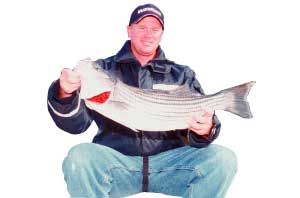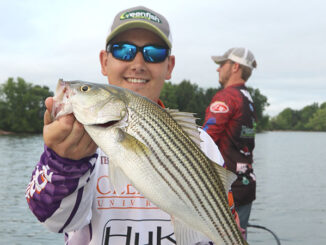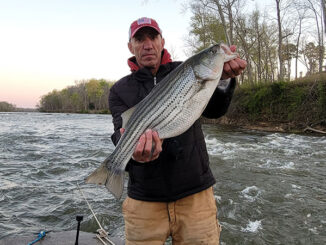
When I was a kid, my buddies and I got into a habit — we’d go deer hunting in October, November and December, and in January, February and March, we’d go striper fishing.That’s a habit that, thankfully, I haven’t been able to break.
I still think about big bucks in the fall and big stripers in the winter, and I probably always will because in South Carolina, when deer season winds down, striper fishing is really getting cranked up big-time.
In the winter when the water gets cold, that’s when you need to go striper fishing. You get the water temperature down in the mid-40s and the stripers get more active. Our coldest weather is usually in late January and early February, and that’s the best striper fishing time.
I’m more familiar with Lake Murray than anywhere else, but most of what I do can apply to other lakes with stripers.
The first thing you need to do is look for the birds — terns and sea gulls that show up in the winter. One of my favorite sayings is “Birds fish for a living, too,” and that’s true.
When you find birds, they’ll be around baitfish, and you can count on stripers to be in the same areas. Depending on the weather and the barometer, they can be schooling on the surface or right on the bottom.
If you have a sunny, bluebird day, they won’t move up, and that’s when I like to bounce a spoon. I like to use a smaller spoon because a lot of your threadfin shad will be dying, and you’re trying to “match the hatch.”
One thing I really like about spoon fishing for stripers is it can help you build confidence in your electronics, your depth-finders.
I think there are a lot of people who aren’t really good at reading their electronics, but when you’re fishing in the winter, you can get around fish and you can get right over your transducer and actually see the baitfish and pinpoint the stripers. That can do a lot for your confidence.
I use a Lowrance X-15, and I’m constantly looking at it. The birds can tell you the area the baitfish are in, but you need to look at your electronics to target the stripers. First, I look for the clouds of bait, then I look for the bigger fish around the bait, the inverted “V’s” that are the stripers.
You want the stripers to be around the bait. Ideally, you can find some bait that will be on the bottom, but really, finding fish around the bait is the most important thing you can do. I’d hate to tell somebody to pass up fishing near a school of suspended baitfish.
When the water temperature really drops, the baitfish will slow down, but the stripers will get much more aggressive.
I like to really snap a spoon up off the bottom with my wrists, then slowly follow it back down, but you have to let the fish tell you how to work a spoon. If you’re bumping one around, using the same rhythm, and you don’t get a fish for 5 minutes, try something else. It’s all about rhythm. It’s just like fishing a crankbait; it’s what feels good to you and the fish.
I try to fish as sensitive a rod as I can when I’m bouncing a spoon. I fish a 6-1/2-foot All-Star baitcasting rod, graphite, with a medium to medium-heavy action, with 14-pound Trilene Sensation line. Some people want fiberglass rods and line with no stretch, but I think Sensation is a happy medium.
Most people really don’t feel what’s going on when they’re fishing a spoon, but it’s just like fishing a pig-n-jig. You’ve gotta know what’s going on all the time.
You pop that spoon off the bottom 3 feet, and when you let it fall back, it only falls 2 feet, you have to know that and set the hook. You feel just a little twitch or see your line jump just a little bit, you set the hook.
You take a striper — he can feel that 1/2- or ¾-ounce piece of metal in his mouth, and he’ll blow it out before you can set the hook, so it’s very important for people to really get to know what their spoon feels like at all times when they’re fishing it.
One thing I do with every jigging spoon I tie on is replace the hook that comes with the bait with a No. 4 Owner treble, a red, needlepoint hook. I think the red color really makes a big, big difference.
I usually will have spoons rigged with and without a bucktail or a feather because sometimes, it matters one way or the other.
If you’re fishing in stained water, that white bucktail or feather may give a striper a little something extra he can zero in on. In clear water, that red No. 4 treble hook on the spoon will usually be enough.
Something I really like about bumping a spoon for stripers is that you’re going to be catching fish all day when you get on ’em — but they won’t all be stripers. You can pick up white perch, white bass, hybrids, largemouths, and I’ve had some of my biggest five-fish weights with largemouth by bumping a spoon off the bottom at Lake Murray.
In a day’s time, you might catch 100 white bass or white perch, 10 or 15 stripers and six or eight largemouths, and the biggest five might go 30 pounds.
One thing I caution people about when they’re fishing a jigging spoon is to take it easy on fish when you’re bringing them up. There’s no need to rush; it’s cold and they’re sluggish, and you don’t want to horse them up and get them to thrashing around because the weight of that spoon will give them plenty of leverage to throw it.
Topwater fishing is a lot more fun, but you don’t get to do it quite as often. You’ve got to have an overcast day for the fish to feed at the surface.
When I find them there, I like to use a small spoon with a little bucktail tied on, or just a bucktail.
One of my favorite lures is a Berkeley Power Shad fished on a quarter-ounce jighead. That can be deadly for stripers feeding on shad at the surface.
Davy Hite is a 40-year-old native of Saluda, S.C., who now resides in Ninety Six, S.C. He has fished professionally since 1993, when he qualified for his first Bassmasters Classic. He was the BASS Angler of the Year in 1997 and 2002, and he has won the 1999 Bassmasters Classic and the 1998 FLW Tour Championship. He is sponsored by Triton boats, Evinrude outboards, All-Star rods, Pfleuger reels, Pure Fishing (Berkeley), Owner hooks and Solar-Bat sunglasses.




